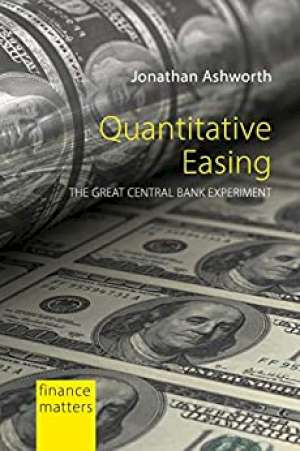26 November 2020
Quantitative Easing:
The Great Central Bank Experiment
Jonathan Ashworth
2020, Agenda Publishing, 192 pages,
ISBN 9781788212229
Reviewer: Dean Turner

With every (major) central bank currently employing QE, there is little doubt that this is a topic with which most of us are familiar. This shouldn’t put you off picking up this book. If anything, I would encourage you to pick it up to refresh yourself on the details of how and why we got to where we are today.
“Quantitative Easing” by Jon Ashworth is a comprehensive and detailed analysis of what is, in terms of central banking history, still a relatively new tool in the policymaker’s box. Everything you have learned and experienced over the last decade (and forgotten) on the subject of QE is covered, in detail, in this book.
The book begins by reminding the reader how central banking used to be, which is easy to forget after years of independence from the interference of politicians, and more than a decade of virtually zero interest rates in the major developed economies. The author then takes us through the events that led to QE essentially becoming the primary policy tool for central banks as they scrambled to deal with the aftermath of the Great Financial Crisis.
However, the more interesting part of the book comes when it turns to the key questions around the effectiveness of QE. In general, most of the literature out there, some of it from central banks, concludes that QE has been effective, but perhaps not as much as initially hoped. Moreover, each subsequent round of stimulus packs less of a punch – a point worth remembering as central banks clamour to buy up more and more bonds.
Of course, whether QE has been effective is one thing but, as economists, we know better than most that there is no such thing as a free lunch. Chapters six and seven address some of the potential distortions that arise externally (international spill-overs) and domestically. The current phase of QE makes the first wave pale into insignificance. So, therefore, could the spill-overs, which gives these chapters an extra degree of relevance. Questions such as the impact on wealth distribution, asset markets, and government finances are returning to the fore.
The final chapter of the book turns to the question now on everyone’s lips: what can central banks do when QE has reached its limits? The book makes clear that what we currently call “unconventional” in terms of monetary policy has become conventional. QE is going to be with us for many years to come, and may increasingly become the policy instrument of choice.
The book was written before the Covid-19 crisis hit. In the meantime, there have been some major changes by central banks with regard to monetary policy and their mandates. This is going to be an evolving situation. The book discusses a few of the possible options available to central banks if QE is no longer found to be effective, but I think this is an area which deserved more attention. If there is one criticism I have, it is that there aren’t enough radical ideas in this section (although that is easy to say as the person who hasn’t had to write the book!).
In summary, in circa 150 pages the author manages to provide the reader with a complete and interesting overview of one of the most important topics in our time.
